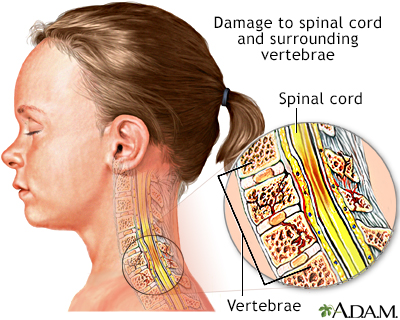Pregnancy SmartSiteTM
Autonomic hyperreflexia; Spinal cord injury - autonomic dysreflexia; SCI - autonomic dysreflexia; Sympathetic hyperreflexia DefinitionAutonomic dysreflexia (AD) is an abnormal, overreaction of the involuntary (autonomic) nervous system to stimulation. This reaction may include:
CausesThe cause of AD is spinal cord injury, most often due to spine trauma. The nervous system of people with AD over-responds to the types of stimulation that do not bother healthy people. Other conditions may cause autonomic dysfunction (not dysreflexia) which has similar symptoms, including:
SymptomsSymptoms can include any of the following:
Sometimes there are no symptoms, even with a dangerous rise in blood pressure. Exams and TestsYour health care provider will do a complete nervous system and medical exam. Tell your provider about all the medicines you are taking now and that you took in the past. This helps determine which tests you need. Tests may include:
Other conditions share many symptoms with AD, but have a different cause. The exam and testing help your provider rule out these other conditions, including:
TreatmentAD is life threatening, so it is important to quickly find and treat the problem. A person with symptoms of AD should:
Proper treatment depends on the cause. If medicines or illegal drugs are worsening the symptoms, they must be stopped. Any illness needs to be treated. For example, the provider will check for a blocked urinary catheter and signs of constipation which may cause AD in someone with a spinal cord injury. The person should be checked for injuries, sores, or other irritants that may be triggering the symptoms. If a slowing of the heart rate is causing AD, medicines called anticholinergics (such as atropine) may be used. Very high blood pressure needs to be treated quickly but carefully, because the blood pressure can drop suddenly. A pacemaker may be needed for an unstable heart rhythm. Outlook (Prognosis)Outlook depends on the cause. People with autonomic dysfunction due to a medicine usually recover when that medicine is stopped. When AD is aggravated by other factors, recovery depends on how well the disease can be treated. Possible ComplicationsComplications may occur due to side effects of medicines used to treat the condition. A sudden severe increase in blood pressure can cause a stroke or bleeding into the brain. Long-term, severe high blood pressure may cause seizures, bleeding in the eyes, stroke, or death. When to Contact a Medical ProfessionalContact your provider right away if you have symptoms of AD. PreventionIn people with spinal cord injury, the following may help lessen AD symptoms:
ReferencesBenarroch EE, Freeman R. Autonomic disorders. In: Goldman L, Cooney KA, eds. Goldman-Cecil Medicine. 27th ed. Philadelphia, PA: Elsevier; 2024:chap 386. Khanna R, Fessler RD, Snyder L, Fessler RG. Spinal cord trauma. In: Jankovic J, Mazziotta JC, Pomeroy SL, Newman NJ, eds. Bradley and Daroff's Neurology in Clinical Practice. 8th ed. Philadelphia, PA: Elsevier; 2022:chap 63. McDonagh DL, Barden CB. Autonomic dysreflexia. In: Fleisher LA, Rosenbaum SH, eds. Complications in Anesthesia. 3rd ed. Philadelphia, PA: Elsevier; 2018:chap 131. | ||
| ||
Review Date: 6/13/2024 Reviewed By: Joseph V. Campellone, MD, Department of Neurology, Cooper Medical School at Rowan University, Camden, NJ. Review provided by VeriMed Healthcare Network. Also reviewed by David C. Dugdale, MD, Medical Director, Brenda Conaway, Editorial Director, and the A.D.A.M. Editorial team. View References The information provided herein should not be used during any medical emergency or for the diagnosis or treatment of any medical condition. A licensed medical professional should be consulted for diagnosis and treatment of any and all medical conditions. Links to other sites are provided for information only -- they do not constitute endorsements of those other sites. No warranty of any kind, either expressed or implied, is made as to the accuracy, reliability, timeliness, or correctness of any translations made by a third-party service of the information provided herein into any other language. © 1997- A.D.A.M., a business unit of Ebix, Inc. Any duplication or distribution of the information contained herein is strictly prohibited. | ||


 Central nervous sy...
Central nervous sy... Central nervous sy...
Central nervous sy... Spinal cord injury
Spinal cord injury
